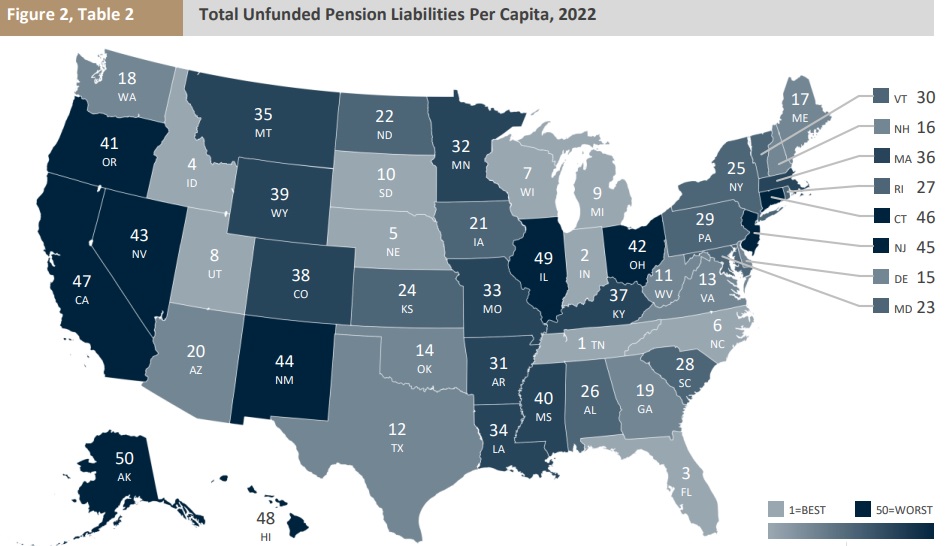America’s big national challenge with retirement income is a deeply indebted Social Security system.
There’s also a significant problem at the state level, where many governors and state legislators have made extravagant promises of lavish retirement benefits to their (overpaid) bureaucrats.
But, in many cases, they haven’t set aside enough money to fulfill those promises.
The underlying problem is that states generally rely on the approach know as “defined benefits,” which means that they promise bureaucrats specific amounts of money based on factors such as salary and years of service.
But promising the money is easy, especially since government employee unions often are big contributors to the politicians making those promises.
A far better approach is use the “defined contribution” approach, which is the same model as the IRAs and 401(k)s that are common for private sector workers. The government pays specific amounts into the accounts of bureaucrats, who then decide how and when to use their funds in retirement.
The Wall Street Journal opined on this issue earlier this week. Here are some excerpts.
Unfunded pensions for public workers have become a huge fiscal burden on many states, and the smarter states like Florida have moved to limit future liabilities by moving to defined-contribution plans. That makes it all the more strange that Alaska may risk its future fisc by returning to defined-benefit pensions. …The plan would pay retirees a fixed amount annually… Payments would rise automatically with inflation each year… Retirees with three decades of experience would keep about 63% of their salaries, up from 53% today. …In 2006 Juneau replaced its fixed pensions with 401(k)-style plans. Retirement costs were growing so rapidly at the time that the main public-employee fund remains about $3 billion short of full funding today, though it’s added no new members since it was closed. Restoring the old pension system could deepen this hole in a hurry. An analysis by the Reason Foundation…projects a $9 billion liability over the long run. …Republican Gov. Mike Dunleavy hasn’t taken a definite position. It should be an easy choice. Public-worker pensions create incentives for ever-higher taxes as current politicians seek near-term political support by adding to taxpayer liabilities that have to be paid on some future Governor’s watch. Down that road lies New Jersey or Illinois.
Fortunately, the waffling governor does not have to look very far for a better choice.
As explained by Ryan Frost for Reason, some lawmakers in the state’s House of Representatives instead want to expand the state’s defined contribution system.
Two competing public employee pension bills reached the Alaska House of Representatives last week. One would revert Alaska back to a fiscally unsustainable public pension plan that adds to the state’s debts, while the other would maintain important reforms and even allow the state’s teachers to access a better, more flexible retirement plan. …House Bill 302 (HB 302), sponsored by Rep. Ben Carpenter (R-Nikiski), would leave the defined contribution retirement plan (DCRP) open, increase the employer contribution rates for public safety, and—crucially—open access to the Supplemental Benefit System-Annuity Plan (SBS-AP) to teachers. …Under HB 302, public safety employer contributions would be substantially increased from 5% of pay to 9.74% of pay. …the decisions between House Bill 302 and Senate Bill 88 could well define Alaska’s fiscal landscape for generations to come, either ensuring a legacy of prudent, responsible stewardship of the state’s public sector retirement system or adding billions in debt for future Alaskans to pay.
The bottom line is that Alaska used to have a terrible system, and the state still has a huge unfunded liability because of that old system.
So it’s almost incomprehensibly foolish that some politicians in the state want to resuscitate the defined-benefit approach. Especially since they could expand their existing defined-contribution system instead.
P.S. For more information on the handful of state and local governments with defined-contribution systems, click here, here, and here.
P.P.S. Even though Alaska has a good tax system, that doesn’t mean it has good fiscal policy. The state collects a lot of energy taxes and that money finances a bloated (and often corrupt) government. Hopefully state lawmakers will wise up and enact a spending cap.




